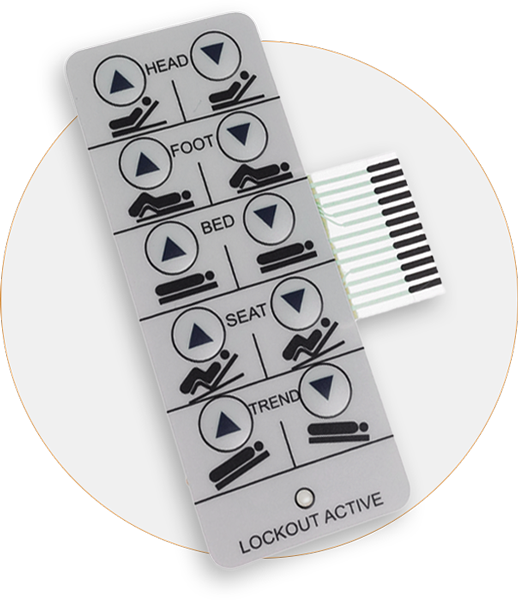Essential Features to Look for When Picking a Membrane Switch
Essential Features to Look for When Picking a Membrane Switch
Blog Article
Recognizing the Functionality of Membrane Layer Changes for Interface Instruments
The capability of membrane switches over stands for a considerable development in interface style, combining performance with aesthetic versatility. These buttons operate through a multi-layered framework that translates customer interactions right into electrical signals, enabling both compact designs and durability against ecological aspects. As industries significantly prioritize customer experience, comprehending the subtleties of membrane button technology comes to be vital. What implications do these improvements hold for future applications, and how might they redefine individual communications across different tools?
What Are Membrane Buttons?
Membrane layer buttons are cutting-edge interface tools that assist in individual communication with digital tools. These functional components consist of several layers, consisting of a visuals overlay, spacer, and a published circuit layer. The style permits a smooth integration into different digital gadgets, improving both the aesthetic and practical aspects of customer interfaces.
Membrane layer buttons are frequently utilized in a variety of applications, from family appliances to industrial machinery and clinical tools. Their building and construction typically includes a thin account, making them an excellent selection for portable styles. The tactile comments offered by these switches can be crafted to satisfy details customer preferences, guaranteeing effective interaction between the user and the tool.
Longevity is an additional considerable advantage of membrane layer switches, as they are resistant to dirt, wetness, and chemicals, which enhances their life-span popular atmospheres. Furthermore, these switches can be customized in regards to shape, dimension, and graphic design, permitting branding and user-specific features. Overall, membrane layer changes stand for a functional service for boosting individual experience in electronic gadgets, integrating functionality with visual charm in a reliable way.
Exactly How Membrane Switches Over Job
Operating on an uncomplicated principle, membrane layer switches make use of a layered building and construction to register individual input effectively. Each button includes several layers, including a published circuit layer, a spacer layer, and a top visuals layer, which are designed to interact perfectly. When a customer presses the leading layer, it presses the spacer layer, bringing the conductive aspects of the circuit layer right into call with each other.
This call creates a closed circuit, indicating the device to carry out a details function. The style permits for various setups, including responsive feedback, which can enhance the customer experience by giving a physical feeling upon activation. The materials utilized in membrane layer buttons typically consist of adaptable substrates, such as polyester or polycarbonate, which ensure toughness and durability against wear and tear.

Secret Benefits of Membrane Layer Switches

One more significant benefit is their compactness. Membrane layer buttons are thin and lightweight, which makes it possible for manufacturers to save space in their devices without giving up functionality. This attribute is especially helpful in applications where weight and volume are vital considerations.
Furthermore, membrane buttons are resistant to dust, dampness, and chemicals, improving their resilience. This strength extends their life-span and lowers the demand for constant substitutes, resulting in expense financial savings over time.
Furthermore, the responsive responses offered by membrane layer switches can be maximized to boost individual communication. They can consist of functions such as raised buttons or distinct clicks, improving functionality and customer experience.
Applications Throughout Industries
Interface devices utilizing membrane layer buttons prevail in a vast array of markets, showcasing their adaptability and capability. Membrane Switch. In the medical industry, membrane layer buttons are essential to tools such as analysis equipment and individual this page tracking systems, where their toughness and convenience of cleaning are important for keeping hygiene requirements. In a similar way, in the automotive market, these buttons are used in control panel controls and infomercial systems, providing a smooth and contemporary interface for individuals.
Furthermore, the consumer electronics industry take advantage of membrane switches in appliances and handheld devices, where portable layout and user-friendly user interfaces boost customer experience. Industrial applications additionally utilize membrane layer changes for control board in equipment and automation systems, stressing their toughness and resistance to rough settings.
In the aerospace and defense industries, membrane check out here buttons are made use of in cockpit controls and equipment, where reliability and efficiency under severe conditions are critical. Additionally, the video gaming industry significantly incorporates membrane layer buttons in controllers and game machines, adding to an engaging customer experience. Generally, the adaptability of membrane switches over enables their widespread usage throughout various sectors, emphasizing their relevance in modern interface style.
Future Trends in Membrane Layer Switch Modern Technology

Furthermore, making use of advanced materials, such as polycarbonate and polyester films, is anticipated to climb, offering improved resilience and resistance to environmental stress factors. These materials add to the overall long life of membrane switches, making them appropriate for harsher commercial applications.
Furthermore, the unification of smart technology, including IoT connectivity, will allow membrane layer buttons to connect Home Page with various other tools and systems, helping with a much more interactive individual experience. This pattern lines up with the expanding need for wise devices across different markets, from health care to customer electronics.
Finally, personalization choices are anticipated to expand, allowing manufacturers to create bespoke solutions tailored to specific customer demands and choices. These developments will position membrane buttons as crucial parts in the development of interface modern technology.
Verdict
Finally, membrane layer switches over represent a pivotal advancement in interface modern technology, using a dependable and versatile remedy for varied digital applications. Their layered construction facilitates portable design, while functions such as tactile feedback boost individual communication. The durability versus environmental elements better strengthens their utility across several industries. As innovations in material scientific research and touch sensing technologies proceed, the performance and applicability of membrane layer switches are anticipated to broaden, strengthening their significance in modern-day electronic tools.
Report this page